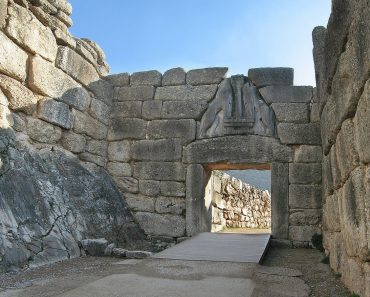Archaeologists excavating the ancient Greek city of Phanagoria on Russia’s Taman Peninsula have uncovered the first concrete evidence of classical theater in the Black Sea colony. The discovery—a 2,200-year-old terracotta satyr mask fragment—represents a milestone in understanding the cultural and religious life of one of the largest ancient Greek settlements in the region.
The find was made by the Phanagoria Archaeological Expedition, supported by the Oleg Deripaska “Volnoe Delo” Foundation. Measuring nearly 30 centimeters (12”) in length, the mask fragment preserves the left side of the satyr’s face, complete with exaggerated cheekbones, a large ear, and thick beard reports Arkeonews. The painted details are still visible: a blue-outlined eye and reddish beard and mustache, characteristic features of masks used in New Comedy performances during the 2nd century BC.
According to researchers, the size, stylistic details, and perforations for straps confirm that this was a genuine theatrical prop rather than a miniature votive mask.

Ancient Greek comedy and tragedy masks were essential elements of theatrical performances. (Tilemahos Efthimiadis/CC BY 2.0)
Dionysian Theater Culture Revealed
Greek actors traditionally used masks to embody different roles and to project emotions to audiences in large open-air theaters. Distinctive colors and facial exaggerations helped identify characters: a fiery red beard, for instance, signaled hot temper and unruly nature. The satyr mask fragment aligns with the well-known iconography of Dionysus’s goat-footed attendants, depicted with disheveled hair and horseshoe-shaped mustaches.
The discovery suggests that Phanagoria, like other poleis of the Bosporan Kingdom, maintained a vibrant cultural life that included theatrical performances and Dionysian festivals. Theater was not merely entertainment—it was deeply tied to religious rituals honoring Dionysus, god of wine and ecstatic transformation.
During Mithridates VI Eupator’s reign (120–63 BC), when the king embraced Dionysus as his divine patron, the cult flourished in Phanagoria. Theatrical masks, processions, and imagery of Dionysus and his companions appeared widely on coins, ceramics, and votive objects of the era.

Aerial view of the ancient Greek city of Phanagoria archaeological site (Phanagoria Museum)
Archaeological Context and Significance
The satyr mask fragment was unearthed in the central part of the ancient city, near what researchers believe could have been the location of the theater. Smaller ritual masks, no more than 10 centimeters in height, had previously been recovered from shrines in Phanagoria—two depicting satyrs and one a comic actor. These miniature masks were affixed to wooden posts and offered to the gods with prayers for healing.
However, the newly discovered large-scale mask marks the first direct archaeological evidence of a functioning theater in Phanagoria. Dr. Vladimir Kuznetsov, head of the Phanagoria Expedition, emphasized: “There is no doubt that Phanagoria had a theater. We suggest it was located on a hill with a commanding view of the sea and the city of Panticapaeum—modern Kerch—the capital of the Bosporan Kingdom.”

Miniature ritual masks of satyrs and a comic actor previously found in Phanagoria. (Oleg Deripaska Foundation ‘Volnoe Delo’)
Cultural Legacy of a Forgotten Metropolis
Founded around 543 BC by Greek colonists from Teos, Phanagoria rapidly became one of the most important settlements on the Taman Peninsula. Archaeological excavations have revealed extensive necropoleis, royal palaces linked to Mithridates, and early Christian basilicas, demonstrating the city’s continuous cultural evolution.
The find reinforces the view that Greek cultural traditions took deep root in Black Sea colonies, blending with local practices and influencing subsequent civilizations. The mask’s Dionysian symbolism underscores the city’s close identification with the cult of the god of wine, fertility, and transformation—a cult that celebrated ecstasy and played a political role in legitimizing rulers.
For archaeologists, the satyr mask represents more than an artifact—it is tangible proof of the sophisticated cultural life that flourished in this ancient metropolis, bridging the gap between written sources and material evidence of theatrical traditions in the classical world.
Top image: Artistic reconstruction of the 2,200-year-old satyr theater mask discovered in Phanagoria. Source: Volnoe Delo Foundation
By Gary Manners







